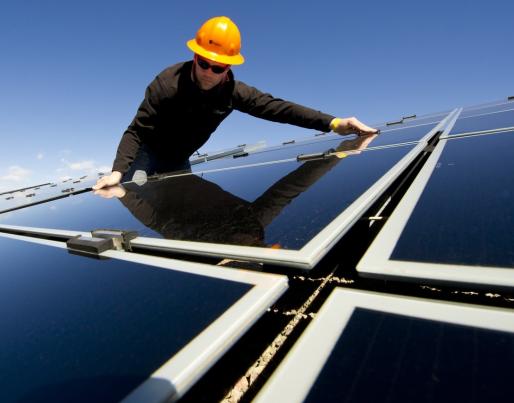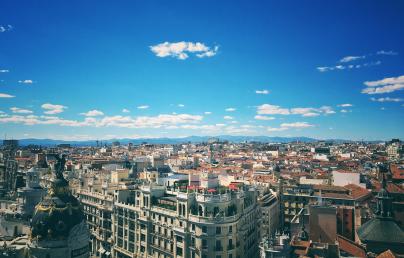
OVERVIEW | An Introduction to Energy Communities: the interplay with the building sector and the role of technology

OVERVIEW | An Introduction to Energy Communities: the interplay with the building sector and the role of technology
Transforming our energy systems and increasing the share of renewable energy requires, amongst other things, an increasing engagement of citizens. People will play a key role in the management of energy flows, combining their traditional role as consumers with active participation in the production process, thereby becoming prosumers.
In its 2030 Climate Target Plan, the European Commission presented a new objective for greenhouse gas (GHG) emissions reduction of at least to 55% compared to 1990. This goal can only be achieved by accelerating the clean energy transition driven by various actions that also give citizens a central part. The energy communities can play a crucial role to implement this aspect.
The Energy Community concept and legislation were introduced through the Clean Energy for all Europeans Package where two types of energy communities are defined:
- The Renewable Energy Communities (REC) presented in the revised Renewable energy directive -REDII (2018/2001/EU)
- The Citizien Energy Communities (CEC), introduced in the Directive on common rules for the internal electricity market ((EU) 2019/944)
An Energy Community should be an open, non-discriminatory association whose members can be citizens, local authorities (including municipalities), or small enterprises. Both definitions describe a way to ‘organise’ collective cooperation of an energy related activity around specific ownership, governance and a non-commercial purpose (as opposed to traditional market actors).
The primary purpose of both CECs and RECs is to provide environmental, economic or social community benefits for its members or the local areas where they operate rather than financial profits. Also, both definitions emphasise participation and effective control by citizens, local authorities and smaller businesses whose primary economic activity is not in the energy sector. Finally, participation in CECs and RECs must be open and voluntary.
However, there are also some differences. For instance, the main objective of CECs is to constitute an entity that enables the prosumers to participate in the electricity market. On the other hand, the RECs have the key objective to increase the share of renewable energy sources in the Member States. Conversely to CEC, which has no geographical limitation and where the energy generation is neutral but limited to the electricity sector, in RECs the generated energy relies only on local renewable sources.
This concept of proximity is not well-defined in the directive and the proper definition and applications are left to the national laws of the Member States. Also, RECs are not limited to electricity but can cover any form of renewable energy including, for instance, in the heating sector.
The following sections will discuss self-consumption, energy sharing and renewable energy communities and underline the way in which technology can facilite the energy interactions within and between buildings. Finally, we will present some relevant examples resulting from Horizon 2020 projects.
Self-consumption, energy sharing and renewable energy communities: advantages of renewable energy sources
It is known that the building sector can play an important role in the establishment of energy communities because a multi-apartment building or a district can form a community, sharing the same energy and environmental targets. This concept becomes even more interesting if we look at the benefits that co-operation can offer for renewable energy self-consumption. The concept of self-consumption refers to the possibility to consume on-site the energy generated by a renewable power unit (e.g. photovoltaic) to meet the user demand.
Individual self-consumption is based on the fact that the owner of the generation unit uses the energy only for its own consumption and either stores the surplus in storage systems or feeds it into the grid. This approach, combined with proper energy saving techniques, leads to environmental benefits due to the use of renewable energy sources (RES) and reduces the amount of energy drawn from the distribution grid, thereby contributing to the profitability of the investment.
Collective self-consumption refers to the case when two or more members share, within a particular site, the energy generated by RES. Examples of collective self-consumers are dwellers of the same building, or the owners of different stores in a shopping mall.
The RECs can involve buildings located in a district or in a particular urban area. Currently, the geographical limitation of a REC changes from country to country and depends on the national implementation of the REDII. For instance, in Italy only members under the same secondary substation can constitute a REC; in Austria the division is performed at the grid level; in France there is a differentiation between urban area (within 2 km) and rural area (20 km).
In that context, it is important to highlight that the implementation of RECs in the future can be supported by platforms mplementing peer-to-peer energy trading and sharing, creating a virtual pool to connect for example energy storage systems within neighbourhood.
Renewable energy communities: technical implementation and social aspects
To support the implementation and tapping the potential of RECs, many technologies can facilitate the monitoring of consumption, thereby helping community members to save and consume their energy properly. Indeed the success of RECs and of their environmental benefits will largely depend on technical and social actions which can leverage the flexibility of the buildings.
The energy consumption reduction will result not only from the building’s envelope retrofitting, but also from the deployment of information and comunication technology (ICT) solutions which collect data from sensors and are able to suggest to the final users how to optimise their final consumption.
The maximisation of self-consumption from photovoltaic energy can also be fostered by using suitable energy storage systems. Storage could be a fundamental technology in the REC development because it allows prosumers to accumulate the surplus energy generated during the day and to supply the electricity when the renewable source is limited or absent (for example at night-time).
According to the chosen control policy, the storage system can be shared among the users living in the same building or among all REC members. Moreover, it can also be used to shave and shift the power peak and to smooth possible demand-supply imbalances to mitigate the impact on the distribution grid.
Renewable energy community participation can yeld a financial benefit (following the reduction of the electricity bill) and deliver social and environmental benefits. The economic benefits may be distributed among the members of the renewable energy community. Therefore, another key aspect in REC design is identifying the most suitable business model and ensuring a fair allocation of the benefits among participants.
An effective energy sharing policy between REC members will better contribute to the decarbonisation of the energy sector by increasing the exploitation of renewable energy and reducing greenhouse gas emissions.
EU horizon 2020
The H2020 programme has supported energy community development in many ways. Some interesting projects in this field which are relevant to buildings are summarized below. Among other things, the COMPILE project developed a digital platform called ComPilot which can be used to create Virtual Social Energy Communities. It is an extension of the community management platform developed in a previous H2020 project (WISEGRID), aiming to investigate to what extent different members of an energy community can be made active through a socio-technological platform.
This tool, properly combined with a building energy management system developed in the same project, is able to run advanced algorithms to optimise not only the consumption, but also the demand-supply with different energy vectors. This approach highlights the central role that buildings play in an energy community management system.
In UP-STAIRS project, local authorities and citizens work together to remove barriers to citizen participation in the transition from a consumer-market to a ‘prosumer-market’. Energy communities are foreseen to be set-up and supported by one-stop-shops managed by local authorities in 5 pilot regions.
In the LIGHTNESS project, the concept of energy community is based on the CEC definition. Therefore, it is a legal entity with the aim to empower citizens to generate and sell renewable-based energy, improving the sustainability and the democracy of the energy sector. The project aims at increasing citizens’ engagement to promote RES-based energy exchanges and to reduce energy consumption and decrease CO2 emissions . The project will also provide policy recommendations and guidelines for governments, professionals and policy makers.
The implementation of local energy communities through an energy hub is the concept proposed in the eNeuron project. In this case, the solutions tend to focus on the optimisation of energy flows considering different energy carriers and sectors (electricity, heating, mobility) trying to maximise the RES used and minimising the overall energy consumption. Proper identification of regulatory and technical bottlenecks will help to explore the scalability and replicability of the proposed concept for different local energy networks present in the project (such as a city, football stadium, naval district, and university campus).
Identify steakholders segments to join in energy communities through the definition of target actions is the aim of the DECIDE project which involves a complementary group of experts on social science, policy and regulation, implementation, energy aggregation and energy services.
Last but not least, it is important to mention also the CULTURAL-E project dedicated to Plus Energy Buildings (PEBs). The solutions proposed by this project are not completely focused on energy communities but establish important guidelines for designing cost-effective PEBs taking into account the possible social, cultural and climatic differences in various European countries.
Within the project, tasks are dedicated to investigate and analyse how to optimise the flexibility from buildings taking into account both the thermal and the electricity demand. The objective is to create a positive energy building and to understand if such a building can benefit from energy community schemes. The output of this analysis tends to demonstrate how the energy benefits for a community (especially for a REC) would increase if the generation and the demand profiles of the buildings are different.
Conclusions
To achieve decarbonisation and increase the use of RES, the future energy system will need to be more citizen-oriented, and will be based not only on sophisticated control, but also on final user awareness. In the building sector, technology can be an enabler for energy communities to provide new services and support user engagement and participation in the energy transition.
The Energy Community concept lays the foundation for the formalisation of this role. However, it is important to mention that the legislative framework for energy communities may evolve with the revision of the Renewable Energy Directive, expected in July 2021 and with the implementation at the national level.

Source: Ulrike Leone on Pixabay.

